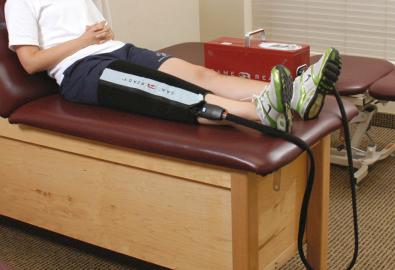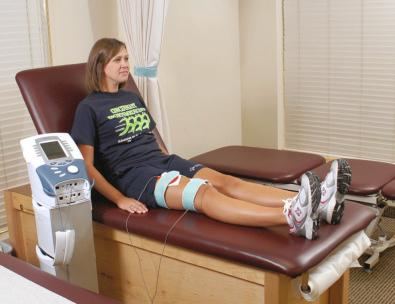Physical Address
304 North Cardinal St.
Dorchester Center, MA 02124
Initial rehabilitation goal: prevent excessive compressive and shear forces through limited weight bearing
Rapid healing of peripheral meniscus repairs
Delayed healing of complex meniscus repairs in middle third region
Further delayed healing of meniscus transplants (1-2 yr)
Preoperative patient counseling and education during entire rehabilitation program are paramount.
Premature return to high-impact loading activities (jogging, deep knee flexion, pivoting) risks repeat meniscus tear or tear to transplant.
Obtain lateral and anteroposterior x-rays 1 and 6-8 weeks after meniscus transplantation to verify position of osseous component.
The postoperative program for meniscus repair and transplantation is shown in Table 25-1 . Because high compressive and shear forces can disrupt healing meniscus repair sites (especially radial repairs) and transplants, the initial goal is to prevent excessive weight bearing. Variations are built into the protocol according to the type, location, and size of the meniscus repair and whether concomitant procedures (such as ligament reconstructions) are performed. The surgeon has the responsibility to inform the physical therapy team of details regarding the type of tear and repair that was performed. Meniscus repairs with all-inside fixators have inferior holding strength and commonly, only a few sutures are used. These repairs require more protection during the first 6 postoperative weeks to allow for healing. Inside-out meniscus repair techniques, on the other hand, involve multiple vertical divergent sutures (see Chapter 23 ) and have superior holding strength.
| Weeks | Months | ||||||||
|---|---|---|---|---|---|---|---|---|---|
| 1-2 | 3-4 | 5-6 | 7-8 | 9-12 | 4 | 5 | 6 | 7-12 | |
| Long-leg postoperative brace | C, A, T | C, A, T | C, T | ||||||
| Range of motion minimum goals: | |||||||||
| 0-90 degrees | X | ||||||||
| 0-120 degrees | X | ||||||||
| 0-135 degrees | X | ||||||||
| Weight-bearing: | |||||||||
| Toe touch to 50% body weight | P | ||||||||
| 75%-100% body weight | P | ||||||||
| Toe touch to 25% body weight | C, T, A | ||||||||
| 50%-75% body weight | C, T, A | C, A | |||||||
| 100% body weight | T | C, A | |||||||
| Patella mobilization | X | X | X | ||||||
| Stretching: Hamstring, gastrocnemius-soleus, iliotibial band, quadriceps | X | X | X | X | X | X | X | X | X |
| Strengthening: | |||||||||
| Quadriceps isometrics, straight-leg raises, active knee extension | X | X | X | X | X | X | X | X | X |
| Closed-chain: gait retraining, toe raises, wall-sits, minisquats | P | C | X | X | X | X | X | ||
| Knee flexion hamstring curls (90 degrees) | P | C | X | X | X | X | X | ||
| Knee extension quadriceps (90-30 degrees) | X | X | X | X | X | X | X | ||
| Hip abduction-adduction, multi-hip | X | X | X | X | X | X | X | ||
| Leg press (70-10 degrees) | P | P | X | X | X | X | X | ||
| Balance/proprioceptive training: Weight shifting, minitrampoline, BAPS, BBS, plyometrics | P | X | X | X | X | X | X | X | X |
| Conditioning: | |||||||||
| Upper body ergometer | X | X | X | ||||||
| Bike (stationary) | X | X | X | X | X | X | |||
| Aquatic program | X | X | X | X | X | ||||
| Swimming (kicking) | P, C | X | X | X | X | ||||
| Walking | X | X | X | X | X | ||||
| Stair-climbing machine | P, C | P, C | P, C | P, C | X | ||||
| Ski machine | P | P | P | C | X | ||||
| Running: straight * | P | P | C | X | |||||
| Cutting: lateral carioca, figure-eights * | P | P | X | ||||||
| Full sports * | P | P | X | ||||||
* Return to running, cutting, and full sports is based on multiple criteria (see text). Patients with noteworthy articular cartilage damage are advised to return to light recreational activities only.
Clinicians should be aware that meniscus repairs located in the periphery (outer third red-red [R/R] region) heal rapidly, whereas complex repairs that extend into the central third red-white (R/W) region tend to heal more slowly and require greater caution. In addition, modifications to the postoperative exercise program may be required if noteworthy articular cartilage deterioration is found during the arthroscopic procedure. This rehabilitation program has been used at our institution in hundreds of meniscus transplant and repair recipients, and the results of clinical investigations demonstrate its safety and effectiveness in restoring normal knee motion, muscle, and gait characteristics.
Patients receive instructions before surgery regarding the postoperative protocol. Thus, they have a thorough understanding of what is expected after surgery. Patients are warned that an early return to strenuous activities such as impact loading, jogging, deep knee flexion, or pivoting carries a definite risk of a repeat meniscus tear or tear to the transplant. This is particularly true in the first 4 to 6 postoperative months.
Before surgery, the surgeon screens for any deep vein thrombosis (DVT) risk factors, including a prior patient or family history suggestive of an inherited coagulation defect. In women, all estrogen products and oral contraceptives are stopped 1 month before surgery.
The supervised rehabilitation program is supplemented with daily home exercises. The therapist routinely examines the patient in the clinic to implement and progress the appropriate protocol. Therapeutic procedures and modalities are used as required for successful rehabilitation. On average, patients require 11 to 16 physical therapy visits over a period of 9 to 12 months to produce a desirable result.
Lateral and anteroposterior plain radiographs are obtained 1 week after surgery to verify the position of the osseous component of meniscus transplants and at 6 to 8 weeks to verify healing and retention of the bony portion of the transplant within the slot or tunnels. Any onset of tibiofemoral joint line clicking or pain may indicate failure of the meniscus repair or transplant, and the surgeon should be notified immediately for consideration of refixation.
Knee effusion, pain, gait, flexion and extension, patellar mobility, lower extremity strength and flexibility, tibiofemoral joint symptoms
Postoperative compression dressing, long-leg brace, compression stockings, cryotherapy, lower limb elevation, pain management
Excessive pain or swelling
Quadriceps shutdown
Limitation knee flexion, extension
Saphenous nerve irritation
Early detection and treatment of complications are critical.
Important early postoperative signs for the therapist to monitor include effusion, pain, gait, knee flexion and extension, patellar mobility, strength and control of the lower extremity, lower extremity flexibility, and tibiofemoral symptoms indicative of a meniscal tear ( Table 25-2 ). The protocol to prevent DVT that includes aspirin (325 mg, 2 ×/day), compression dressings, thromboembolic hose, early ambulation, and active ankle pumps (performed hourly) is carefully followed.
| Postoperative Sign or Symptom | Treatment Recommendations |
|---|---|
| Continued pain in the medial or lateral tibiofemoral compartment of the meniscus repair or transplant | Physician examination, assess need for refixation or repeat repair |
| Tibiofemoral compartment clicking or a subjective sensation by the patient of “something being loose” within the tibiofemoral joint | Physician examination, assess need for refixation or repeat repair |
| Failure to meet knee extension and flexion goals | Overpressure program, early gentle manipulation under anesthesia if 0-135 degrees not met by 6 postoperative weeks |
| Decreased patellar mobility (indicative of early arthrofibrosis) | Aggressive knee flexion, extension overpressure program, or gentle manipulation under anesthesia to regain full ROM and normal patellar mobility |
| Decrease in voluntary quadriceps contraction and muscle tone, advancing muscle atrophy | Aggressive quadriceps muscle strengthening program, EMS |
| Persistent joint effusion, joint inflammation | Aspiration, rule out infection, close physician observation |
Patients present to physical therapy on the first day after surgery on bilateral axillary crutches in a postoperative dressing with a long-leg brace locked in full extension. The postoperative bandage and dressing are changed to allow the application of thigh-high compression stockings and a compression bandage. Early control of postoperative effusion is essential for pain management and early quadriceps reeducation. In addition to compression, cryotherapy is critical during this time period. Patients receive a commercial cooling unit, which is used 6 to 8 times daily at home. In the clinic, the use of various cryotherapy machines provides compression simultaneously with the cold program ( Fig. 25-1 ).

Patients are instructed to maintain lower limb elevation as frequently as possible during the first week. A portable neuromuscular electric stimulator may be helpful for quadriceps reeducation and pain management ( Fig. 25-2 ). These devices are used 4 to 6 times per day, 15 minutes per session, until the patient displays an excellent voluntary quadriceps contraction.

The patient's initial response to surgery and progression during the first 2 weeks sets the tone for the initial phases of the rehabilitation program. Common postoperative complications include excessive pain or swelling, quadriceps shutdown or loss of voluntary isometric contraction, range of motion (ROM) limitations, and saphenous nerve irritations for medial repairs. Monitor patient complaints of posteromedial or infrapatellar burning, posteromedial tenderness along the distal pes anserine tendons, tenderness of the Hunter canal along the medial thigh, hypersensitivity to light pressure, and hypersensitivity to temperature change. These abnormal symptoms or signs occur in early cases of complex regional pain syndrome (see Chapter 40 ) and require immediate medical treatment.
All patients receive a long-leg postoperative brace immediately after surgery to prevent hyperflexion and rotation of the knee that may damage the repair or transplant. The brace is opened from 0 to 90 degrees, but it is locked at 0 degrees of extension at night for the first 2 weeks. Thereafter, the brace is not routinely locked except in patients who cannot maintain 0 degrees of extension. In these cases, the brace is locked at 0 degrees of extension as required during the day and night. The brace is used for 4 weeks.
Crutches with partial weight bearing are recommended for the first 4 weeks in all cases. Weight bearing is gradually progressed as shown in Table 25-1 , and patients are encouraged to use a normal gait that avoids a locked knee and assumes normal flexion throughout the gait cycle. Patients who had a repair of a radial meniscus tear are kept non–weight bearing for 4 weeks to protect the repair site.
Begin passive flexion, passive and active-assisted extension exercises on first postoperative day, 0-90 degrees.
Goal: 135 degrees by 5-6 weeks
Become a Clinical Tree membership for Full access and enjoy Unlimited articles
If you are a member. Log in here